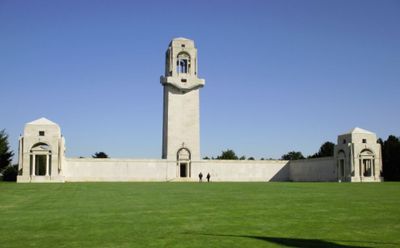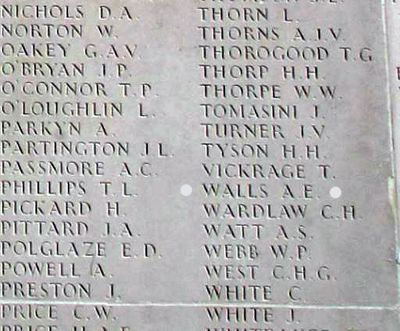Difference between revisions of "Albert Edward John Walls"
From Our Contribution
| Line 51: | Line 51: | ||
| label13 = Reg Number | | label13 = Reg Number | ||
| − | | data13 = 3300 | + | | data13 = [https://recordsearch.naa.gov.au/SearchNRetrieve/Interface/ViewImage.aspx?B=8399935 3300] |
| label14 = Date of Enlistment | | label14 = Date of Enlistment | ||
Revision as of 14:59, 14 September 2017
 | |
| Personal Information | |
|---|---|
| Date of Birth | not known |
| Place of Birth | Moonambel, Victoria |
| Death | 10 Jun 1918 |
| Place of Death | Morlancourt, France |
| Age at Enlistment | 30 years, 5 months |
| Description | 5'4¼" (1.m) tall; weight 128 lbs (kg); dark complexion, brown eyes, dark brown hair. |
| Occupation | sleeper cutter |
| Religion | Church of England |
| Address | Canning Mills, Western Australia |
| Next of Kin | Father Mr Daniel Walls |
| Military Information | |
| Reg Number | 3300 |
| Date of Enlistment | 6 Sep 1915 |
| Rank | Private |
| Unit/Formation | 28th Battalion, 7th reinforcement / 7th Brigade,2nd Division |
| Date of Embarkation | 13 Jan 1916 - 16 Feb 1916 |
| Ship Embarked On | HMAT A7 Medic |
| Fate | Killed in Action 10 Jun 1918 |
| Monument | none at present |
| Medals |
British War Medal Victory Medal |
Contents
Pre War
Electoral Roll entry - 1916 Canning Mills, sleeper hewer
War Service
Entered Blackboy Hill camp on 6 Sep 1915, and on 1 Nov 1915 he was allocated to the 7th reinforcement draft for the 28th Battalion, and travelled with them to Egypt where soon after they were sent on to France.
In Alexandria on 21 Mar 1916 he boarded SS Oriana and disembarked in Marseilles on 27 Mar 1916. In Marseilles he was hospitalised in the Lahore Stationary Hospital from 9 - 22 Apr 1916 with influenza, and thus was no taken on strength by the 28th Battalion until 3 May 1916 as they moved into the trenches in the Bois Grenier area.
On 27 Jun 1916 Albert was admitted to hospital suffering from shell shock caused by what the war diary considered to be a feeble enemy response to their own bombardment of enemy lines. Seen by the 8th Casualty Clearing Station he was placed on an Ambulance Train for the 14th Stationary Hospital in Boulogne.
Embarked on HMHS St Patrick in Boulogne on 29 Jun 1916 he was evacuated to England where he was admitted to the 3rd London General Hospital. Discharged from 1st Australian Auxiliary Hospital in Harefield to the No 1 Command Depot in Perham Downs on 16 Aug 1916 he was not returned to France until 3 Feb 1917 when he exited England through Folkestone.
On arrival in Étaples he was quickly moved on to the 28th Battalion and he rejoined them on 8 Feb 1917 at 'Acid Drop Camp' near Fricourt where as the Brigade's Reserve battalion they were providing working parties to support those in the front lines. On 1 Jun 1917 he presented to the 7th Australian Field Ambulance who sent him on to the 56th casualty Clearing Station a week later with Trench fever. Placed on an Ambulance Train , he was sent to the 6th General Hospital in Rouen, and on 24 Jun 1917 he had recovered sufficiently to be transferred to the No 2 Convalescent Depot.
By 27 Jul 1917 he had been released to the 2nd Division's Base Depot in Le Havre, and on 14 Aug 1917 he again caught up with his unit who were rebuilding and training in a rear area.
During an attack on Westhoek Ridge south of Ypres, Albert was wounded in action a second time. He was wounded by shrapnel to the leg on 20 Sep 1917 and after basic treatment by the 6th Australian Field Ambulance he was sent to the 3rd Canadian Casualty Clearing Station and on to the 32nd Stationary Hospital in Wimereux on 21 Sep 1917. On 3 Oct 1917 he was released to the Convalescent Depot, and he rejoined the 28th Battalion on 14 Oct 1917 near Steenvorde on the border with Belgium. He remained with them until 14 Jan 1917 when he was granted leave in England, returning to the Battalion on 31 Jan 1918.
During the week prior to 10 Jun 1918, the 28th Battalion was in the line east of Morlancourt in the Somme Valley. At dusk the 28th Battalion along with others of the 7th Brigade attacked the southern section of the Morlancourt Spur that overlooked Sailly-Laurette on the Somme. Although the attack was deemed a great success, it is when Albert was Killed in Action. Initially buried 1200 yards southwest of Morlancourt, his grave could not be found later and thus he is commemorated on the Villers-Bretonneux Memorial.
Notes

